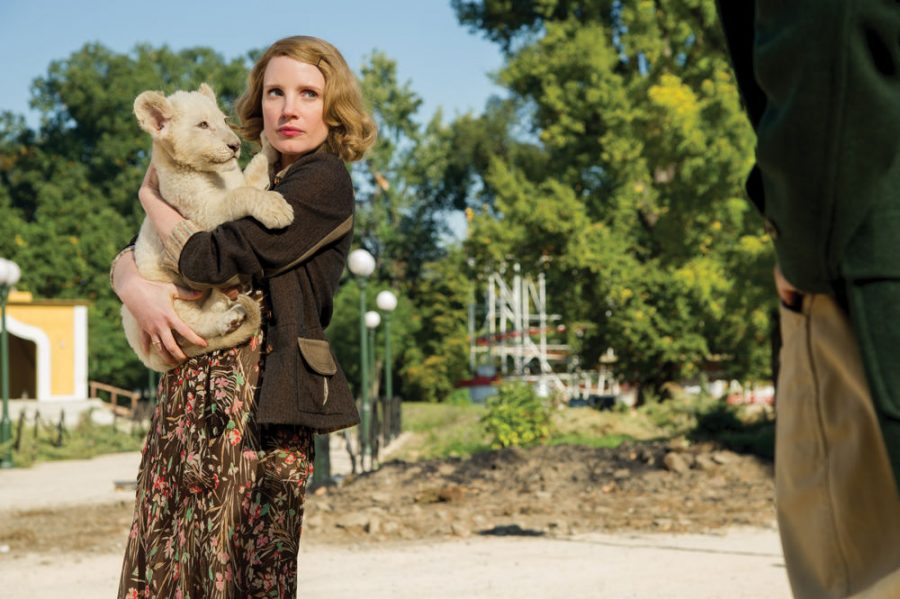Taut WWII drama ‘Zookeeper’s Wife’ shines light on true story
Published March 30, 2017
“The Zookeeper’s Wife” is an inspiring true story about a couple who saved 300 Jews from the Nazis during World War II by hiding them in their Warsaw zoo. After the war, Israel recognized Antonina and Dr. Jan Zabinski as Righteous Among the Nations, yet their story is little known.
Jessica Chastain plays Antonina, who ran the Warsaw Zoo alongside her zoologist husband, Jan (Johan Heldenbergh), while raising their son in their villa on the zoo grounds. The film opens in 1939, with scenes of the devoted couple caring for animals and working side-by-side tending the zoo.
Antonina is shown caring for lion cubs in their bedroom, making rounds on her bicycle with a camel following behind and opening the zoo gates before taking their son to school. Shy with people, Antonina has a magical skill with animals, making her indispensable at the zoo.
The couple are helped in their work by loyal employee Jerzyk (Michael McElhatton, who plays Roose Bolton in “Game of Thrones”).
Moving and beautifully filmed, “The Zookeeper’s Wife” is directed by Niki Caro, whose previous films include “Whale Rider.” The screenplay by Angela Workman was adapted from Diane Ackerman’s book of the same name, which was based on Antonina’s diaries.
When the Nazis attack Warsaw, the zoo is bombed. Exhibits are destroyed, many animals are killed and wild animals are released into city streets. Shots of animals wandering the streets are among the film’s more striking and unusual visuals.
The devastated zoo falls under the jurisdiction of the Nazis’ newly appointed chief zoologist, Lutz Heck (Daniel Bruhl), whom the Zabinskis knew as a fellow zoologist and animal lover before the war. Heck seemed to them to be rational and kind, so the Zabinskis are shocked when he transforms into a committed Nazi.
The zoo is to be shut down, but Heck offers to save some of their prize stock by transferring them to his zoo in Germany. He also plans to launch an ideologically driven genetic program to re-create extinct European species such as the auroch, a bisonlike bovine, through a breeding program at their zoo, using one of their bison.
The Zabinskis are not Jewish, but their best friends are. When Maurycy (Iddo Goldberg) is ordered to report to the Warsaw Ghetto, the couple offer to hide his girlfriend, Magda (Israeli actress Efrat Dor), in their home.
Appalled by Nazi brutality, Jan and Antonina devise a plan to hide more Jews in their now nearly empty zoo. With its complex of tunnels to safely transport animals, underground pens and storage, it proves an ideal place to hide hundreds of people. They offer Heck a plan to keep the zoo going by raising pigs in their animal pens to feed German soldiers. To feed the pigs, Jan suggests the garbage from the Jewish ghetto, a plan that gives him easy access to smuggle people out.
Although the couple worked together to save people from the Nazis, Chastain as Antonina is the true star of this film. Once smuggled out, Jan works with the Resistance to find permanent hiding places for the escapees, whom they call guests. This means Jan is often gone, leaving Antonina alone to cope with deflecting Nazi attention from what is going on at the zoo. She also does what she can to make their guests feel comfortable. They hide and sleep in the day but, at midnight, when the Nazi guards leave, she plays her piano – their signal that it is safe to come out of hiding and into the house. The Zabinskis’ house in the middle of the zoo is isolated enough to allow them a little freedom and normalcy.
Jan’s trips outside the zoo into Warsaw’s streets and its ghetto reveal the horror unfolding, details he protectively does not share with his sensitive wife. It is some of the film’s hardest footage to watch, but essential to the film’s story.
Beautifully shot, “The Zookeeper’s Wife” is tense and touching. The period costumes and locations are highlighted in the lush cinematography. This little-known heroic story is inspiring and deserves attention.
However, the film is not perfect. After a strong start, it loses dramatic focus midway, although it recovers by the end. Further, it is plagued by the difficulty of understanding dialogue spoken with heavy accents.
Apart from her accent, Chastain does a wonderful job. Her Antonina is strong and soft, a sweet figure who easily wins our hearts. Sheltering vulnerable people brings out a strength in her, and she handles the Nazi officer Heck as she would a predator that she must distract from the prey she hides.
Bruhl brings an aggressive, predatory side to Heck, who is anamored with the beautiful Antonina. They engage in a dangerous cat-and-mouse game in which she must keep him interested but at bay. Antonina knows it is essential to lull him into complacency and trust, so he does not look too closely at what goes on at the zoo. Heldenbergh as Jan has less to work with, so the character seems a bit one note.
Despite its flaws, the amazing true story and Chastain’s appealing performance makes “The Zookeeper’s Wife” a winning film.















